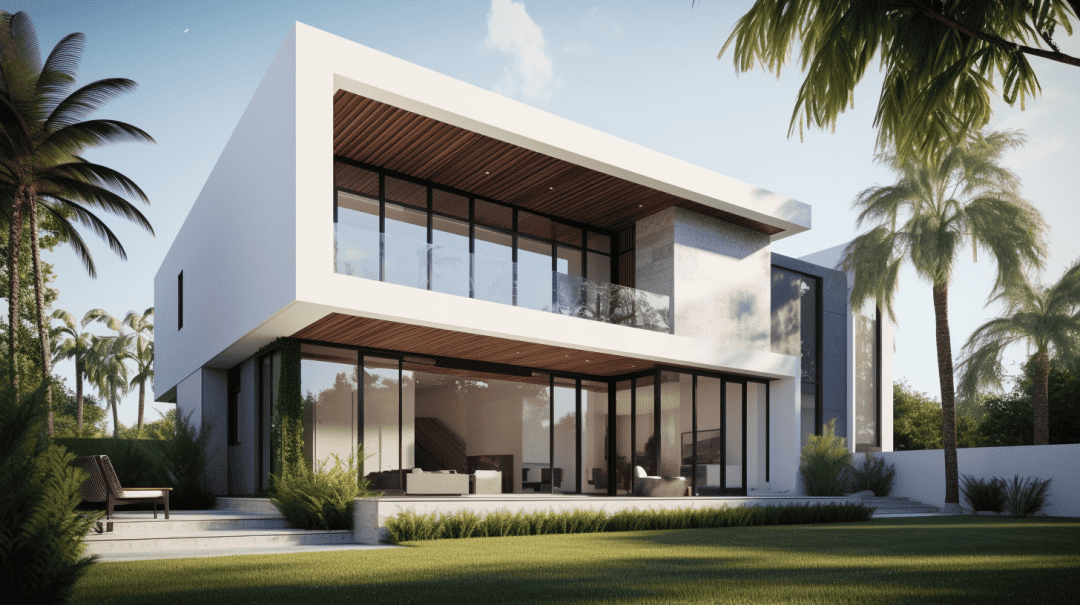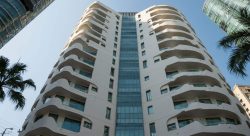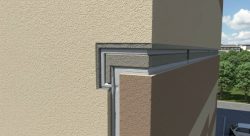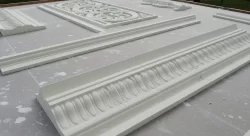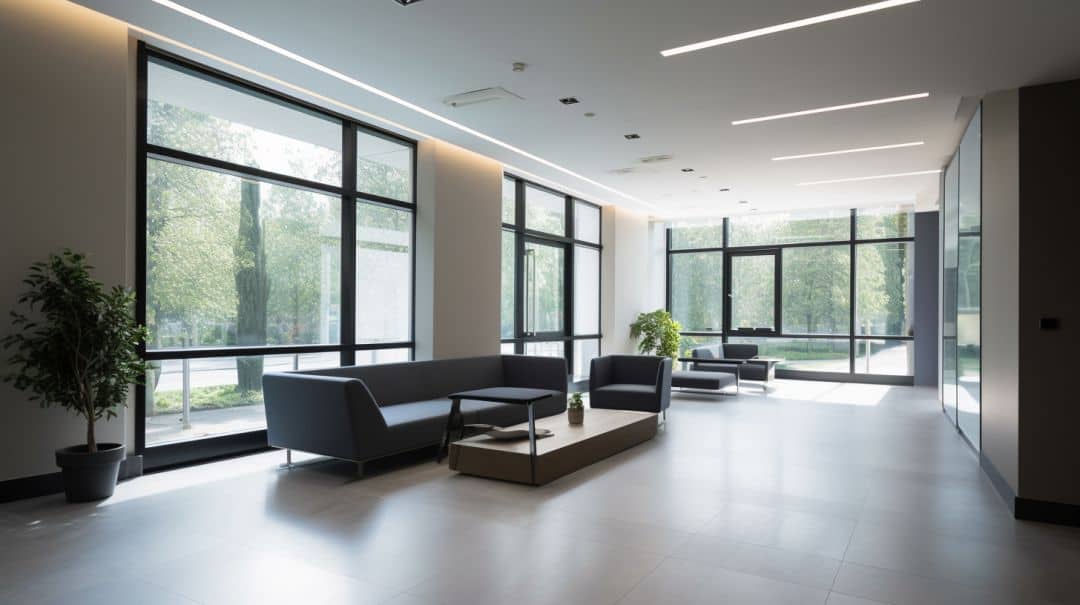Discover Key Requirements and Best Practices for Air Barrier Integration in EIFS and Commercial Wall Systems
When architects and contractors design commercial buildings today, they face a critical challenge. Energy codes are getting stricter. Building performance expectations are rising. And property owners want maximum energy efficiency without compromising durability.
The answer lies in understanding how air barriers integrate with EIFS (Exterior Insulation and Finish System) and commercial wall assemblies. This isn’t just about slapping on another layer—it’s about creating a building envelope that works as a complete system.
After 22 years in the EIFS business, I’ve seen firsthand how proper air barrier integration can make or break a project. Jeff Johnson here, CEO of Indiana Wall Systems, and I’m going to share what architects and contractors need to know about creating airtight, energy-efficient commercial walls.
Key Takeaways
- Air barriers are mandatory in modern commercial construction under current energy codes
- Proper integration with EIFS requires understanding the difference between air barriers and vapor barriers
- Continuous air barrier systems can reduce energy costs by up to 30% compared to traditional assemblies
- Water-resistive barriers and drainage plane design must work together with air barriers for long-term performance
- Professional installation following EIMA guidelines ensures warranty compliance and building code approval
Understanding Air Barriers in Commercial Construction
What Are Air Barriers and Why They Matter
An air barrier is a material or assembly that restricts airflow through the building envelope. Think of it as the building’s windbreaker—it stops conditioned air from escaping and prevents outside air from infiltrating.
Air Barriers vs Vapor Barriers: Key Differences
Air Barriers
Vapor Barriers
Jeff Johnson’s Expert Insight
“In our 22 years of EIFS installation, the biggest mistake we see is contractors thinking these are the same thing. Both are critical, but they solve different problems. Air barriers stop energy loss from air movement. Vapor barriers prevent moisture damage from humidity. Get both right, and your building envelope will perform for decades.”
But here’s what many contractors miss: air barriers are not the same as vapor barriers. This confusion leads to moisture problems down the road.
Air barriers control airflow. Vapor barriers control moisture diffusion. Both are critical, but they serve different functions in your wall assembly.
In commercial construction, air leakage can account for 25-40% of total energy loss. That’s why the International Energy Conservation Code (IECC) now requires continuous air barriers in most commercial buildings.
The Science Behind Air Barrier Performance
Air barriers must meet specific performance criteria:
- Air permeance of 0.02 L/s·m² at 75 Pa pressure differential
- Structural integrity to withstand wind loads and building movement
- Continuity across the entire building envelope
- Durability for the expected building lifespan
Jeff Johnson notes, “In our experience with over 1,200 commercial projects, buildings with properly installed air barriers show 25-35% better energy performance than those without. The payback period is typically 3-5 years.”
EIFS and Air Barrier Integration Fundamentals
How EIFS Components Work with Air Barriers
Modern EIFS systems can function as part of the air barrier assembly when properly designed. Here’s how the layers work together:
Substrate preparation is crucial. The wall structure must provide a suitable base for both the air barrier and EIFS attachment.
Water-resistive barriers often serve dual purposes—controlling moisture and providing air barrier functionality. But not all WRBs qualify as air barriers under code.
Rigid insulation in EIFS provides thermal performance but typically isn’t airtight on its own. Joints between insulation boards create potential air leakage paths.
Base coat and reinforcing mesh can provide air barrier properties when applied correctly, but this requires specific product approvals and installation techniques.
Air Barrier Types Compatible with EIFS
Fluid-Applied Air Barriers
These liquid-applied membranes cure to form a monolithic barrier. They’re excellent for complex geometries and penetration sealing.
Advantages:
- Seamless application around complex details
- Self-flashing properties at penetrations
- Can accommodate structural movement
- Compatible with most EIFS substrates
Considerations:
- Weather-dependent application
- Requires skilled applicators
- Surface preparation is critical
- Multiple coats may be needed
Sheet-Applied Air Barriers
Pre-manufactured membranes that are mechanically attached or adhered to the substrate.
Advantages:
- Consistent thickness
- Predictable performance
- Less weather sensitivity during installation
- Quality control at manufacturing level
Considerations:
- Seaming requirements at joints
- Penetration details require careful attention
- Limited ability to conform to irregular surfaces
- May require primers or adhesives
Board-Applied Air Barriers
Rigid boards that provide both air barrier function and substrate for EIFS attachment.
Advantages:
- Structural capacity for EIFS attachment
- Thermal performance contribution
- Simplified construction sequence
- Excellent for new construction
Considerations:
- Joint sealing is critical
- Limited flexibility for building movement
- May require mechanical fastening
- Cost considerations for material and labor
Commercial Wall Assembly Design Principles
Building Envelope Strategy
Creating an effective building envelope requires understanding how all components work together. The air barrier must be continuous from foundation to roof, with special attention to transitions and penetrations.
Thermal bridging occurs when materials with high thermal conductivity create pathways for heat transfer. Proper air barrier integration helps minimize these effects.
Dew point analysis is essential. When warm, humid air contacts cold surfaces, condensation occurs. Air barriers prevent this by stopping air movement, but the assembly must also manage vapor diffusion.
Wall Assembly Sequencing
The installation sequence affects performance. Here’s the typical approach for EIFS over air barrier systems:
- Substrate preparation and inspection
- Air barrier installation and testing
- Penetration sealing and detail work
- EIFS attachment system installation
- Rigid insulation placement
- Base coat and mesh application
- Finish coat installation
Each step must be completed and inspected before proceeding. This prevents costly repairs later.
Proper Installation Sequence: EIFS with Air Barriers
Substrate Preparation
Clean, inspect, and verify structural integrity. Check moisture content ≤16%. Ensure surface is properly anchored and temperature-conditioned.
Air Barrier Installation
Apply air barrier system per manufacturer specs. Ensure proper thickness, coverage, and cure time. Critical for building envelope performance.
Testing & Quality Control
Perform adhesion testing, continuity checks, and leak detection. Document results. Fix any defects before proceeding.
Penetration Sealing
Seal all penetrations, transitions, and details. Use compatible sealants and follow manufacturer procedures for long-term durability.
EIFS Attachment System
Install EIFS attachment method. Verify compatibility with air barrier. Use appropriate fasteners and adhesives for substrate type.
EIFS System Completion
Install insulation, base coat with mesh, and finish coat. Maintain air barrier integrity throughout process. Final inspection and documentation.
Critical Success Factor
Never skip steps or rush the process. Each phase must be completed and inspected before moving to the next. Weather conditions, cure times, and material compatibility all affect long-term performance. One mistake in sequencing can compromise the entire building envelope.
Critical Detail Areas
Window and door openings require careful air barrier integration. The air barrier must be continuous around these penetrations and properly sealed to the fenestration system.
Expansion joints present unique challenges. The air barrier must accommodate building movement while maintaining continuity.
Roof-to-wall transitions are common failure points. Proper flashing and air barrier continuity are essential.
Foundation transitions need special attention, particularly in below-grade applications.
Code Requirements and Standards
Current Energy Code Mandates
The 2021 International Energy Conservation Code requires continuous air barriers in most commercial buildings. Here are the key requirements:
Annual Energy Savings with Proper Air Barrier Integration
Energy Savings Comparison
Source: Indiana Wall Systems analysis of 160+ commercial projects over 22 years
Climate zones affect specific requirements. Indiana falls primarily in Climate Zone 5A, where continuous air barriers are mandatory for most commercial construction.
ASTM Standards for Air Barriers
ASTM C1397 provides the standard specification for liquid-applied air barriers. This covers material properties, application methods, and quality assurance procedures.
Key performance criteria include:
- Air permeance: ≤ 0.02 L/s·m² at 75 Pa
- Water resistance: No water penetration under specified test conditions
- Vapor permeance: Varies by climate zone requirements
- Adhesion: Minimum pull-off strength requirements
- Flexibility: Accommodation of substrate movement
ASTM E2178 covers air barrier materials and assemblies, including testing protocols for whole-building air leakage.
EIMA Guidelines for Air Barrier Integration
The EIMA (EIFS Industry Members Association) provides specific guidance for incorporating air barriers with EIFS systems. Key points include:
- Air barrier compatibility with EIFS adhesives
- Proper surface preparation requirements
- Quality assurance and testing protocols
- Detail drawings for common conditions
- Warranty considerations
“Following EIMA guidelines isn’t just about code compliance,” explains Jeff Johnson. “It’s about ensuring long-term performance and protecting your warranty coverage.”
Installation Best Practices
Surface Preparation Requirements
Proper substrate preparation is the foundation of successful air barrier integration. The surface must be:
- Clean and free of debris
- Structurally sound and properly anchored
- Within specified moisture content limits
- Temperature-conditioned per manufacturer requirements
Moisture content is particularly critical. Most air barrier systems require substrate moisture content below 16% for proper adhesion.
Surface profile affects adhesion. Rough or porous substrates may require primers or surface conditioners.
Application Techniques
Weather conditions significantly impact installation quality. Temperature, humidity, and wind affect cure times and application characteristics.
Application thickness must meet manufacturer specifications. Too thin, and you won’t achieve required performance. Too thick, and you risk cracking or poor adhesion.
Overlap and seaming details are critical for sheet-applied systems. Proper overlap width and sealing methods ensure continuity.
Quality Control Measures
Testing during installation catches problems early. Common tests include:
- Pull-off adhesion testing
- Wet film thickness measurements
- Continuity testing with electronic leak detection
- Visual inspection for holidays or defects
Documentation is essential for warranty compliance and future maintenance. Record application conditions, material batch numbers, and test results.
Moisture Management in Air Barrier Systems
Understanding Vapor Drive
Vapor drive occurs when water vapor moves from high to low concentration areas. This can happen in either direction depending on seasonal conditions.
In summer, inward vapor drive can occur when humid outdoor air encounters cold, air-conditioned indoor surfaces.
In winter, outward vapor drive happens when warm, humid indoor air moves toward cold exterior surfaces.
The air barrier system must manage both conditions without creating moisture problems.
Drainage Plane Integration
Water-resistive barriers often serve as both air barriers and drainage planes. This dual function requires careful design consideration.
The drainage plane must be continuous and properly detailed to direct water away from the structure. This includes:
- Proper lapping sequences
- Integration with flashing systems
- Weep systems at the base of walls
- Penetration sealing
“We’ve seen too many projects where the air barrier was perfect, but poor drainage plane design led to moisture problems,” notes Jeff Johnson. “Both systems must work together.”
Condensation Risk Management
Dew point analysis helps predict where condensation might occur within the wall assembly. The air barrier location affects this significantly.
Vapor retarders may be needed on the interior side of the assembly in certain climate zones. This prevents interior moisture from reaching cold surfaces where condensation could occur.
Thermal bridging at structural members can create cold spots where condensation risk is higher. Proper insulation and air barrier detailing help minimize this risk.
Common Installation Mistakes and Solutions
Discontinuity Problems
Air barrier discontinuity is the most common installation error. Common problem areas include:
Penetration Sealing Failures
- Insufficient sealant application around pipes and conduits
- Wrong sealant type for the application
- Failure to seal both interior and exterior sides of penetrations
- Poor surface preparation before sealant application
Solution: Use manufacturer-approved sealants and follow detailed application procedures. Pre-fabricated penetration seals often provide better performance than field-applied sealants.
Joint and Seam Issues
- Inadequate overlap at sheet membrane joints
- Poor adhesion due to contaminated surfaces
- Failure to prime surfaces when required
- Incorrect sequencing of overlapping materials
Solution: Follow manufacturer specifications for overlap widths and seaming procedures. Use proper surface preparation and priming as required.
Compatibility Issues
Material compatibility problems can cause adhesion failures or chemical degradation over time.
EIFS Adhesive Incompatibility
Some air barrier materials aren’t compatible with certain EIFS adhesives. This can lead to:
- Poor adhesion of the EIFS system
- Chemical degradation of the air barrier
- Warranty voidance
Solution: Verify compatibility through manufacturer testing or approved system combinations. Don’t mix and match components from different manufacturers without approval.
Substrate Compatibility
- Incompatible primers or surface treatments
- Chemical reactions between materials
- Thermal expansion differences causing failures
Solution: Use only approved material combinations and follow manufacturer recommendations for substrate preparation.
Performance Testing and Verification
Whole Building Air Leakage Testing
Blower door testing measures the air leakage of the entire building envelope. This is required by many energy codes for commercial buildings.
Air Barrier Testing Methods: Professional Verification
Whole Building Testing
- ✓ Code-required for many projects
- ✓ Comprehensive building envelope
- ✗ Must be building-ready
Electronic Detection
- ✓ Real-time leak detection
- ✓ Precise leak location
- ✗ Limited to accessible areas
Thermal Imaging
- ✓ Non-invasive testing
- ✓ Visual documentation
- ✗ Weather dependent
Testing Method Comparison Matrix
| Testing Method | Timing | Code Compliance | Typical Cost | Best Application |
|---|---|---|---|---|
| Whole Building Test | Post-completion | Required | $3,000-$8,000 | Final verification |
| Electronic Detection | During install | Optional | $1,500-$4,000 | Quality control |
| Thermal Imaging | Any phase | Diagnostic | $800-$2,500 | Problem diagnosis |
Indiana Wall Systems Testing Protocol
Our proven 3-phase testing approach: Electronic leak detection during installation to catch problems early, thermal imaging for final verification, and whole building testing for code compliance. This layered approach has helped us achieve a 98% first-time pass rate on commercial projects.
Pro Tip: Invest in electronic detection during construction. Finding leaks before the EIFS goes on saves thousands in remediation costs later.
Test results must typically show:
- Air leakage ≤ 0.40 cfm/ft² at 75 Pa pressure
- Consistent results across multiple tests
- Documentation of leakage sources if limits are exceeded
Pre-testing during construction allows for corrections before final finishes are installed. This is much more cost-effective than post-completion remediation.
Component Testing Methods
Electronic Leak Detection
This method uses pressurization and electronic sensors to locate air leakage paths in the air barrier system.
Advantages:
- Real-time leak detection during installation
- Precise location of problem areas
- Can be performed on building sections
- Immediate feedback for corrections
Infrared Thermography
Thermal imaging can identify air leakage by detecting temperature differences caused by air movement.
Best performed during:
- Significant indoor/outdoor temperature differences
- Controlled pressure differential conditions
- Before interior finishes are installed
Performance Monitoring
Long-term monitoring helps verify that air barrier performance is maintained over time. This can include:
- Annual air leakage testing
- Energy consumption monitoring
- Indoor air quality measurements
- Moisture level monitoring in wall assemblies
Economic Benefits and ROI Analysis
Energy Cost Savings
Properly integrated air barriers with EIFS systems provide significant energy savings. Typical benefits include:
Air Barrier Investment: 10-Year Financial Impact Analysis
Cost vs Savings Analysis (50,000 sq ft Office Building)
Investment Payback Timeline
Beyond Energy: Additional Value Drivers
Higher Lease Rates
Buildings with superior air barriers command 8-12% premium rents due to improved comfort and lower operating costs.
Insurance Benefits
Some insurers offer 5-10% discounts for buildings with verified air barrier systems due to reduced moisture damage risk.
Green Certifications
LEED and Energy Star certifications often require air barrier systems, unlocking tax incentives and market premiums.
Tenant Satisfaction
Improved comfort and air quality lead to 20-30% fewer tenant complaints and higher retention rates.
Bottom Line: Air barrier integration typically pays for itself in 3-5 years through energy savings alone, then continues generating value for decades through improved property performance and marketability.
2021 IECC Air Barrier Requirements by Building Type
| Building Type | Air Barrier Required | Testing Requirements | Max Air Leakage |
|---|---|---|---|
Office Buildings | YES | Whole Building | ≤ 0.40 cfm/ft² |
Retail Spaces | YES | Component OK | ≤ 0.40 cfm/ft² |
Warehouses | VARIES | Material Min | Zone Dependent |
Multi-family (4+ stories) | YES | Whole Building | ≤ 0.30 cfm/ft² |
Note: Requirements based on 2021 International Energy Conservation Code (IECC). Local jurisdictions may have additional requirements.
These savings come from:
- Reduced heating and cooling loads
- Improved HVAC system efficiency
- Better indoor environmental control
- Lower maintenance costs
Property Value Impact
Buildings with high-performance building envelopes typically see:
- Higher lease rates (5-15% premium)
- Lower vacancy rates
- Increased property values
- Better tenant retention
- Lower operating costs
“Property managers tell us that buildings with proper air barrier systems have 20-30% lower tenant complaints about comfort issues,” reports Jeff Johnson.
Construction Cost Considerations
While air barrier systems add upfront costs, they often reduce other expenses:
Cost Increases:
- Air barrier materials and installation
- Additional testing and quality control
- Enhanced details and transitions
Cost Reductions:
- Smaller HVAC systems due to reduced loads
- Lower ductwork and equipment costs
- Reduced electrical costs for HVAC
- Potential rebates and incentives
The net cost impact is often neutral or positive when all factors are considered.
Future Trends in Air Barrier Technology
Smart Building Integration
IoT sensors embedded in air barrier systems can provide real-time performance monitoring. This includes:
- Air leakage detection systems
- Moisture level monitoring
- Temperature and humidity tracking
- Automated alert systems for maintenance needs
Advanced Materials
New air barrier materials offer improved performance:
- Self-healing membranes that seal minor punctures
- Phase-change materials for enhanced thermal performance
- Bio-based materials for sustainability
- Smart membranes that adjust permeability based on conditions
Installation Innovations
Prefabricated air barrier panels reduce field installation time and improve quality control. These factory-manufactured assemblies can include:
- Pre-installed air barriers
- Integrated insulation systems
- Factory-sealed penetrations
- Quality-assured performance
Frequently Asked Questions
How do air barriers differ from vapor barriers in EIFS systems?
Air barriers control airflow through the building envelope, while vapor barriers control moisture diffusion. Air barriers must have low air permeance but can allow vapor transmission. Vapor barriers specifically resist water vapor movement and are typically installed on the warm side of the wall assembly.
Can EIFS components serve as the air barrier?
Yes, certain EIFS base coat systems can function as air barriers when properly designed and installed. However, this requires specific product testing and approval, plus careful attention to continuity at joints and penetrations. Not all EIFS systems qualify as air barriers.
What happens if the air barrier fails after EIFS installation?
Air barrier failure can lead to increased energy costs, comfort problems, and potential moisture issues. Repair typically requires removing portions of the EIFS system to access the air barrier, making prevention through proper installation much more cost-effective than remediation.
Are air barriers required in all climate zones?
Current energy codes require continuous air barriers in most commercial buildings regardless of climate zone. However, specific performance requirements and testing protocols may vary based on local conditions and building types.
How do you test air barrier continuity during construction?
Electronic leak detection and blower door testing are the most common methods. Electronic detection can be performed during installation to identify and correct problems immediately. Whole-building testing verifies overall performance and is often required for code compliance.
What’s the typical warranty coverage for air barrier systems?
Material warranties typically range from 10-20 years, while system warranties may be shorter (5-10 years). Warranty coverage usually requires using approved material combinations, following installation specifications, and completing required testing and inspections.
Next Steps for Your Project
Integrating air barriers with EIFS and commercial wall assemblies requires careful planning and expert execution. The performance benefits are significant, but success depends on proper design, quality installation, and ongoing maintenance.
For architects: Work with manufacturers early in the design process to ensure compatibility between air barrier and EIFS systems. Specify performance requirements clearly and include testing protocols in your specifications.
For contractors: Invest in proper training for your installation crews. The techniques for air barrier installation are specialized and require attention to detail. Consider partnering with experienced contractors for your first projects.
For building owners: Understand that the upfront investment in quality air barrier systems pays dividends through reduced operating costs and improved building performance. Factor long-term benefits into your decision-making process.
At Indiana Wall Systems, we’ve helped hundreds of commercial projects achieve superior building envelope performance through proper EIFS installation and air barrier integration. Our team understands the complexities of modern commercial construction and the critical importance of getting these systems right the first time.
Whether you’re working on a new office building in Indianapolis, a retail project in Carmel, or a multi-family development in Fishers, proper air barrier integration is essential for long-term success.
Don’t let poor building envelope performance compromise your project’s success. Contact Indiana Wall Systems at (765) 341-6020 for expert guidance on air barrier integration with EIFS systems. Our 22 years of experience and 160 years of combined team expertise ensure your commercial project meets today’s demanding performance standards while staying within budget and schedule.
Ready to ensure your next commercial project achieves maximum energy efficiency? Let’s discuss how proper air barrier integration can enhance your building’s performance and your bottom line.

